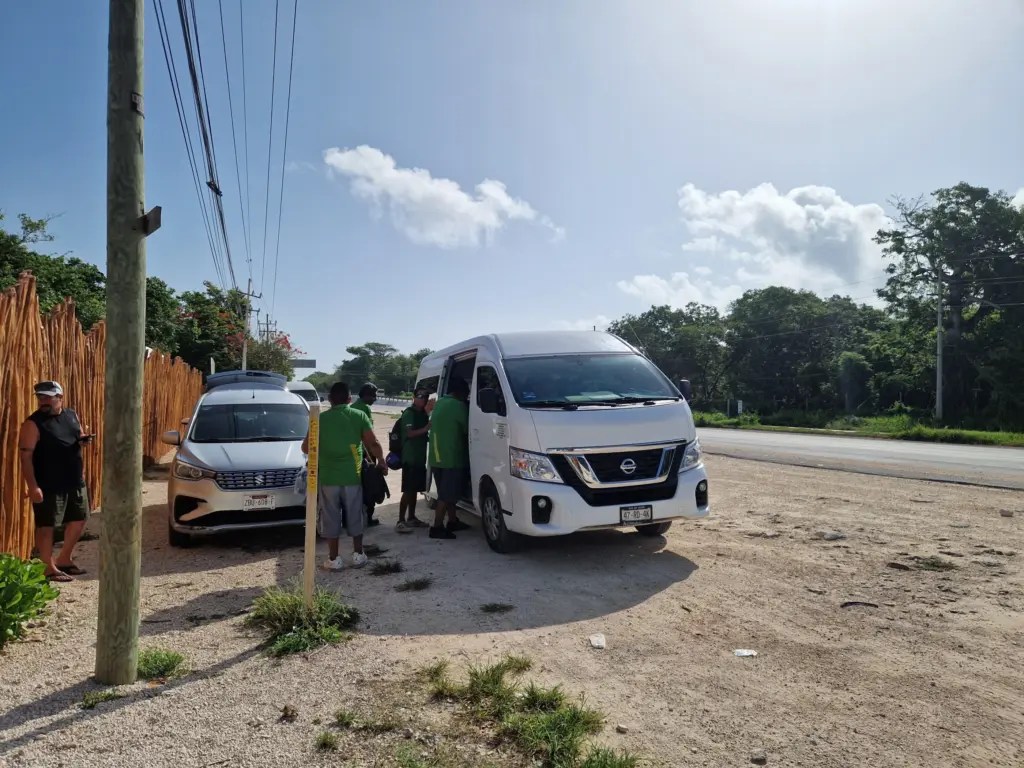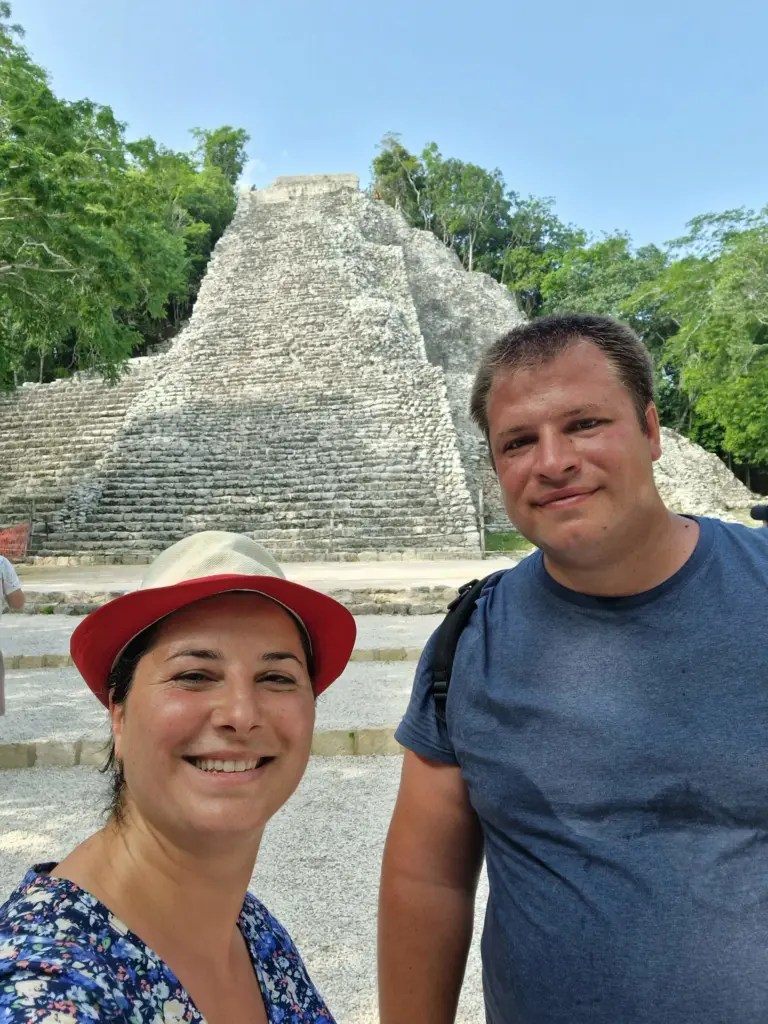From sea-facing temples in Tulum to jungle-wrapped pyramids in Coba, our day trip from Riviera Maya took us deep into the world of the ancient Maya. We explored sacred ruins, cooled off in a stunning cenote, and ended the day with local traditions in a Maya village.
Here’s what the experience was really like and what to know before you go.
- 1. Starting the Journey: From Grand Palladium to Ancient Stones
- 2. First Stop: Tulum Ruins with a View
- 3. Cooling Off Underground: Cenote El Sueño
- 4. Coba Ruins: Ancient Games and a Race Against Time
- 5. A Glimpse into Maya Life: Village Visit and Rituals
- 6. Practical Tips for a Smooth Day Trip
- 7. Book Your Trip to Tulum & Coba
- 8. Final Thoughts: A Mixed Bag with Unforgettable Views
1. Starting the Journey: From Grand Palladium to Ancient Stones

Staying in the Riviera Maya has its perks, and one of them is how close you are to the fascinating ruins of Tulum and Coba. We were based at the Grand Palladium Kantenah Resort & Spa, and decided to dedicate a day to explore these historic treasures.
Our journey began at 8:30 am, hopping on a shuttle arranged by a local tour agency. After a short stop at their headquarters to sort out group logistics, we were back on the road.

For some reason, the local agent who sold our trip on the beach made an error and listed the wrong currency. We then had to straighten out the confusion and make sure we clear the payment. They also asked for some additional currency exchange costs although we didn’t want to pay it.
We would advise to make sure that what you agree with the travel agent that is what you pay, they will simply try to shake the tree and see if they can get more off you under various pretexts.
2. First Stop: Tulum Ruins with a View

By 10 am, we had arrived at Tulum, perched dramatically above the Caribbean Sea. These ruins date back to the 13th century and were once a thriving Maya trading port, especially valuable due to its location by both land and sea.

Unlike other inland sites, Tulum was protected by thick limestone walls and had access to coastal trade routes, making it one of the last great cities built by the Maya.

The tour began with a local guide walking us through the ruins. While the guide gave us a basic introduction, it lacked much depth or storytelling.
Luckily, we had an hour of free time after the guided part, which allowed us to wander through the crumbling structures on our own terms.
One thing to note is that you can’t bring inside the premises plastic including bottles of any sorts with you. They will check rucksacks at the entrance and if found they will confiscate it.

What stood out most was the stunning contrast of ancient stone walls against the deep turquoise of the sea. With the sunlight bouncing off the ocean and casting long shadows across the ruins, it felt surreal.
We took our time soaking in the view and snapping plenty of photos under the blazing sun.
3. Cooling Off Underground: Cenote El Sueño

After Tulum, we made our way to a nearby lunch spot next to a cenote. A cenote is a natural sinkhole resulting from the collapse of limestone bedrock that exposes groundwater underneath—essentially a freshwater pool hidden underground.

These formations are unique to the Yucatán Peninsula and were considered sacred by the Maya, often used for water supply and even ceremonial purposes.
The meal was modest: rice, black beans, fried eggs, and tortillas. Not the highlight of the day, but it did the trick. Thankfully, what came next was a treat.

We descended into Cenote El Sueño, a marvel of nature filled with stalagmites and stalactites. The underground air felt fresh and cool, offering us much-needed relief from the 40-degree heat outside.

This part of the tour felt more immersive. The guide provided a good explanation of how the caves formed and the cenote’s role in Maya culture. Swimming in the clear water beneath ancient formations was easily one of the highlights.
4. Coba Ruins: Ancient Games and a Race Against Time

By mid-afternoon, we were the only ones left on the tour. The rest had dropped out, so it felt like a private experience. Around 4 pm we arrived at Coba, tucked into the jungle and full of mystery.

The ruins featured ball courts similar to those at Chichen Itzá, where we learned a dark but fascinating detail: the winning players were sometimes sacrificed as an honour, granting their families an immediate rise to nobility.

We had 45 minutes to get to Coba’s iconic pyramid, the highest temple in the Yucatán Peninsula. Climbing it is no longer allowed, but standing beneath its towering stone steps was still impressive.

You can rent a bike or hop on a pedicab to get there, as the distance from the main entrance is around a 20-minute walk. We chose to walk, and despite the heat, it was peaceful, weaving through jungle paths before the site closed.
Like what you are reading? Why not join us for other journeys by subscribing to our newsletter:
5. A Glimpse into Maya Life: Village Visit and Rituals

Our final stop was a visit to a “Maya village.” In reality, it was more of a staged cluster of huts set up for tourists. Still, it offered a little cultural insight.

We learned a few basic Maya words, watched a short ceremony led by a shaman, and were offered handmade tacos with egg or pumpkin seed paste. It was a bit underwhelming, but a nice gesture nonetheless.
6. Practical Tips for a Smooth Day Trip

- Bring aqua shoes – The cenote has a rocky floor and can be slippery in places. Aqua shoes will keep your feet protected and make swimming more comfortable.
- Pack a waterproof phone case – You’ll want to snap some photos inside the cenote, and a waterproof case will let you do that worry-free.
- Apply and carry sunscreen – The sun at Tulum was absolutely unforgiving. Even with some shade, we found ourselves constantly reaching for sunscreen.
- Stay hydrated – Bring your own water. Our guides had water, but it was limited and not offered unless we asked. Best to come prepared, especially given the heat.
- Compare tour options online – Before booking through a local vendor, check prices and inclusions on platforms like GetYourGuide or Viator. You might find better value and clearer terms, especially when it comes to what’s included.
Adding these small items to your checklist can really elevate your experience and avoid unnecessary discomfort.
7. Book Your Trip to Tulum & Coba
Check out GetYourGuide for trips similar to what we did. Here are some suggestions.
8. Final Thoughts: A Mixed Bag with Unforgettable Views

Overall, the day trip packed a lot into one day and gave us a memorable look at the Mayan ruins of Tulum and Coba. The scenery was stunning, and the sites themselves absolutely worth visiting.
The cenote was a refreshing surprise, and Coba’s jungle setting felt like stepping into an Indiana Jones film. On the downside, the food was bland and the guiding a bit lacklustre, but for travellers already in the Tulum area, it makes for a convenient and enjoyable adventure.
If you’re planning to visit, wear light clothing, bring water, and prepare for heat. A good pair of walking shoes will make a big difference, especially if you choose to explore Coba on foot.
Ready to book? Below are some recommendations to get your trip started:
- Flights – we use flight aggregators such as Skyscanner and Google Flights to find the best options. You can find more information about finding cheap flights here.
- Accommodation – would recommend booking your accommodation through an aggregator such as Booking.com or Trip.com to get the best rates. We also use TripAdvisor to read reviews.
- Transport – consider DiscoverCars for car renting or if you rely on public transport, you can use Omio for trains, coaches, ferries, airport transfers and even flights.
- Activities – a great option is GetYourGuide, Klook or Viator for tours, excursions, experiences and tickets to many tourist attractions.
- Travel money – we have Starling Bank accounts (UK residents only) with 0% fees on FX and a good Mastercard exchange rate. Revolut is another good option.
- Travel insurance – check SafetyWing for travel medical insurance that works for you and your specific needs.
- Internet abroad – with Airalo or Nomad you can access a wide range of eSIMs (digital SIM cards) available for different countries and regions.
- Luggage storage – if you need to store your bags whilst exploring the destination, you can use Radical Storage to find your closest luggage storage and enjoy your journey until the very end.
As an Amazon Associate and member of various other affiliate programmes, some of the links in this article are affiliate links, meaning at no additional cost to you, we will earn a commission if you click through and make a purchase.
Like what you’ve read? Subscribe to our blog by adding your email address below. You’ll be the first to hear about new destinations and articles we publish!
Are you interested in travelling? Check out our Facebook page and other social media for regular tips and recommendations on how to travel and where to go!


